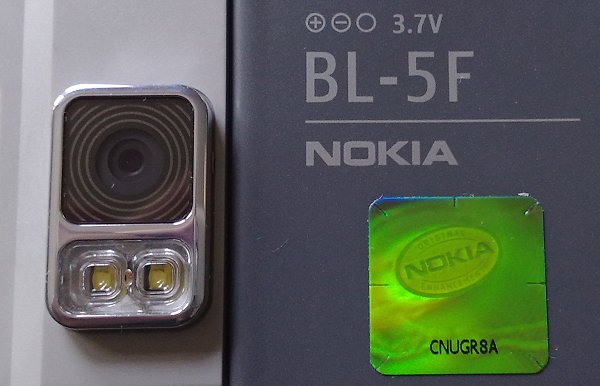Thanks to Nokia's handy (free) utility, Energy Profiler, currently found being promoted in the Ovi Store, I've been able to do a number of tests to work out the power drain for various common phone attributes. Are there any big battery killers that should be left off if possible? I fired up the trusty N96 and set to work. In no particular order:
Network mode

Here, I toggled from 'Dual mode' to 'GSM' and back. The peaks in the chart show the extra processor activity needed to handle my interactions for changing the setting. The flatline bits show the inactive smartphone in each network mode. In my area, there's no greater power drain for either network mode, but I can't stress enough that in areas of poor 3G signal, I'd expect there to be significantly higher power drain in 'Dual mode', as the device struggles to hold on to the shorter range 3G signal. You mileage definitely will vary here!
Display brightness

Here I started the N96's screen on minimum brightness, then ramped up to the default setting, then went to maximum brightness. The difference is around 150mW at most - negligible in normal use, but worth noting if you're planning to have the display on full-time, such as when using your phone for navigation or watching a movie.
Wi-Fi
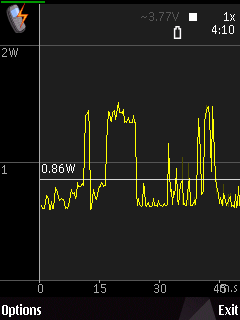
Here I started Web and then went online using Wi-Fi. The interesting thing is the way that the Wi-Fi subsystem in modern phone chipsets manages its power - there are sharp spikes when transferring data (up to an extra Watt) but then there's negligible extra battery drain for much of the extra 'idle' time. Provided you're not straining at the limits of your router's range, the penalty for staying permanently connected at home or at the office isn't worth worrying about, compared to the advantages of always being online, with instant and real time information available.
Headphones vs Speakers
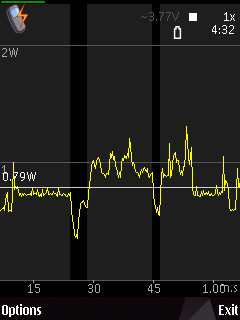
This one came up in a recent Phones Show Chat and I guessed that the extra power drain for using your smartphone's speakers compared to plugging in headphones was negligible, with the processor and RAM hit dwarfing any effects. I wasn't horribly wrong, but you can see above that there is a definite impact. The start and finish sections were with headphones plugged in and then I removed the jack for the middle section. As you might expect, the actual power drain then depends on the sort of audio being played, since we're talking about pushing different volumes of air around. Here you can almost see the beat of the Pink Floyd track being played in the power drain.
So, does it use more power playing music over speakers? Yes, of the order of another 200mW or so. But, again, unless you do this a lot, it's not worth worrying about too much.
GPS
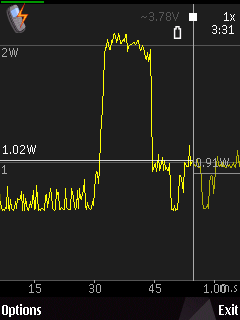
Here's a biggie. Firing up a GPS chip is a big battery worry, as you can see from the chart. While active, GPS draws over a Watt extra, just on its own. Unless you're navigating as a pedestrian, with no choice, I strongly advise buying the £10 Nokia car charger lead and powering your phone through any motoring navigation. With the display on full and the GPS fired up, and possibly a permanent 3G data connection as well, you can easily be draining 2.5W from your phone's battery. A decent 12V to Nokia charger will usually give you up to 3W, so although you may not see much charging effect, at least the power's coming from your car's battery and not from your tiny Nokia cell.
And, if you're just using Google Maps to browse maps and look things up without needing a precise GPS fix, then turn GPS off in the Settings.
Camera

As you might expect, the camera circuitry is a big power drain too, needing an extra half a Watt with just the viewfinder/optics active and an extra Watt briefly when taking a flash photo (as shown above). If you're in the middle of a big photos shoot (e.g. at a party or wedding), then 'Exit' the camera between any shots that don't immediately follow each other.
Note the Camera app resorts to its own standby mode after a lengthy timeout (one minute), which largely achieves the same result.
Bluetooth
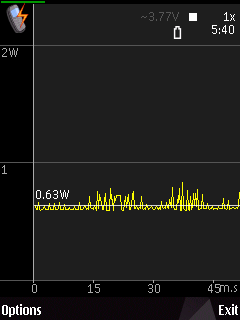
Most power-saving guides recommend turning Bluetooth off when not in use, but as you can see above (the peaks are my activity on the keypad) having Bluetooth on or off ('Off', then 'On', then 'Off' again in the chart) makes very little difference in terms of power drain. So you might as well leave it on all the time, for extra convenience. I do!
And....
In case you were wondering, the baseline, for an inactive S60 smartphone of the N96's class, with all of the above turned off, and with the display off, is around 20 to 30mW - depending on your exact device and chipset, of course, but this is a good guide to what your dormant processor, active RAM and cellular processor require.
Hopefully, knowing the orders of magnitude of the different drains on your smartphone's battery will help you appreciate the power it does give you and help you to string out the life from each charge just that little bit further.
Steve Litchfield, All About Symbian, 24 Dec 2009
